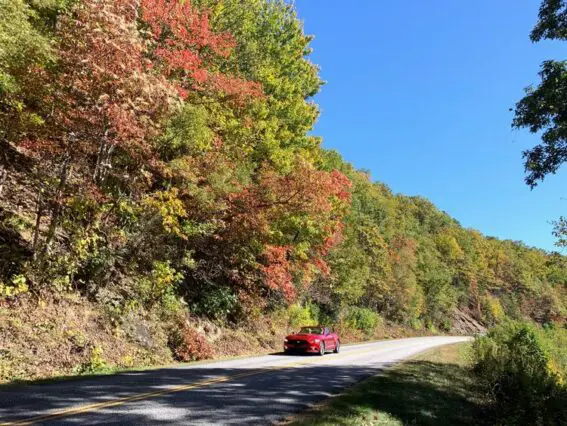Fall color is one of the most visually distinctive aspects of the autumn season…
In most of the United States, people can tell when it’s fall just by looking at the colors on their trees!
In the northern United States, throughout the Southeast — and all the way out to the Rockies and the Pacific shore — September, October, and November bring a vivid array of reds, oranges, golds, purples, and other seasonal color to deciduous trees of many varieties. Even some shrubs and flowering plants get in on the fall color action.
And don’t count Florida out of the fall foliage scene, either! While not known for its vibrant autumn scenery, Florida fall color can be seen in lively patches in places from Central Florida north to the panhandle from mid October into early December.
But how is fall color being touched by climate change? Does global warming affect the vibrancy, timing, or duration of fall foliage?
Here’s everything you want to know about climate change & fall colors…
How Climate Change Impacts Fall Color
While climate change and fall color are two things many folks don’t often put together in the same thought, it stands to reason that fall foliage and the characteristics of each season would be affected by the long-term impacts happening on local, regional, and international levels.
After all, climate change has impacted everything from the length and duration of summertime heat and humidity in the South to the amount of snowfall and ice in the North. We’ve even seen a longstanding trend of more frequent and stronger hurricanes.
But how do rising temperatures, more rainfall, cloudier or sunnier days, and other variables affect fall colors?
Climate change is indeed a different animal — one that we’re still trying to understand.
We know it’s going on, and this is seen in meteorological and climate data pointing to long-term changes that vary significantly from norms long recorded in weather almanacs. Climate change is even affecting the Arctic ice cap, as the average global temperature rises each year.
So, is climate change really having an impact on fall leaf colors?
According to science and actual observations, the answer may be yes…
Factors That Affect Fall Leaf Color
Before we dive into what makes leaves change color in the fall, we need to understand why they do.
Leaves don’t really change color so much as the things that make them green taper off.
Leaves are usually green in the spring and summer because of the presence of chlorophyll.
What is chlorophyll?… It’s a type of naturally occurring pigment that is found in a leaf when its nourished by sunlight, warmer temperatures, moisture, and other life-giving properties found in abundance during a plant’s growing season.
Specifically:
- As the days begin shortening and nights get longer, nutrient flow to leaves stops — which halts the production of chlorophyll.
- At the same time, any remaining chlorophyll that is still inside the leaves starts deteriorating — and this is when the fall color process really ramps up.
- With chlorophyll at bay, carotenoids in the leaves start showing off their beauty by including orange and yellow — which were present in the leaf long before fall.
- Meanwhile, anthocyanin creeps in during the fall as sugars in the leaves and tannins kick in after the other pigments break down — giving a leaf its brown color before it drops off the tree.
How Changes In The Weather Affect Fall Color
As mentioned above, the reduction in sunlight is what turns off the chlorophyll process that keeps leaves green in the spring and summer. But the weather and other factors also drive fall color in these ways:
- Temperature – While decreasing sunlight exposure and longer nights are critical mechanisms that dictate when trees start changing colors in the fall, the onset of colder temperatures can also hasten the fall colors as they affect the tree’s natural seasonal cycle.
- Moisture – Droughts or moisture coming too early or late in the year can affect the timing and brilliance of fall colors. The ideal soil conditions for beautiful fall colors are a warm, rainy spring, a sultry and moist summer, and sunny fall days with crisp nights. That’s the ideal recipe for stunning fall foliage!
- Wind – Wind itself doesn’t produce or necessarily deter the onset of fall colors, but many times when an area is impacted by a wind storm (such as a hurricane or tropical system) at the end of summer, there may be dismal fall leaf peeping conditions.

What Does This Mean For Climate Change Affecting Fall Colors?
By this point, you may have a better understanding of all the things at play in spurring on fall color.
And, with this knowledge, you’ll probably also guess that climate change must have an impact on the timing, duration, and intensity of fall color.
Indeed it does. After all, so many of the variables that go into producing fall colors are directly impacted by climate conditions.
As with so many things involving the science and understanding of climate change, there are still more questions than answers. But Harvard University reported findings from recent studies on the matter…
They monitored 8 tree species over the course of 18 years to see what impact climate change might have on their fall color.
The researchers determined that climate change can directly impact fall color — due to variances in sunlight exposure during a tree’s growing season as well as alterations to the rainy periods in such a way that could hamper the change of colors in the fall.
In all, things aren’t looking all that good based on the findings:
- A warming atmosphere holds more moisture — which can signal rainier days.
- More cloud cover during the growing season can affect photosynthesis — which is connected to the sugars naturally found in leaves and give a leaf its brilliant fall color.
- Long periods of torrential downpours, extended dry weather during the growing season, crippling droughts in the fall, intense heat waves, and other things we’re seeing more of in many parts of the United States can delay fall color or shorten the period of time the autumn colors are most vivid.
The Bottom Line
Does this mean that fall colors may one day become a thing of the past?
That’s not what the research necessarily suggests — but what we may see as time goes on are:
- Shorter periods of vivid fall color in certain parts of the country
- Erratic or spottier occurrences of autumn leaves
- Later fall color seasons
Better do some leaf peeping while the fall colors are still good!
Like this post? Save it to read again later… or share with others on Pinterest!





